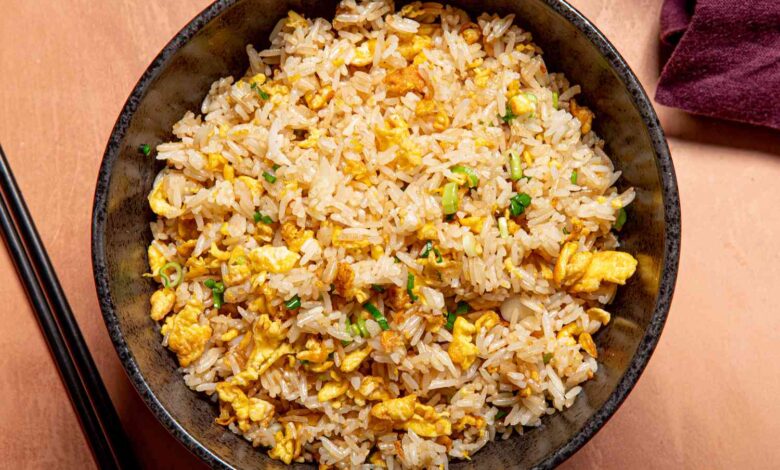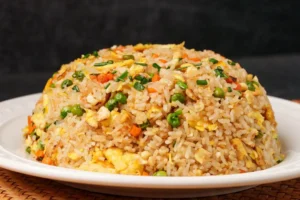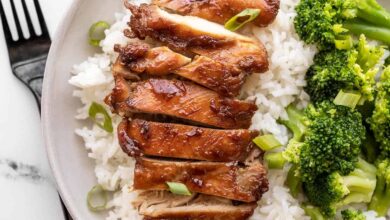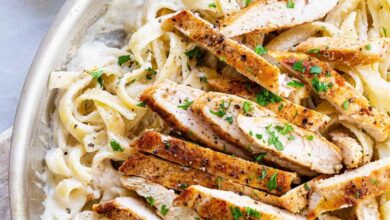Egg Fried Rice Recipe
Egg Fried Rice Recipe

Egg Fried Rice Recipe Introduction:
Egg Fried Rice is a classic stir-fried rice dish known for its delightful combination of fluffy rice, scrambled eggs, and a savory sauce. It is a fantastic way to use up leftover rice and can be adapted with various add-ins based on your preferences. The beauty of Egg Fried Rice lies in its simplicity and flexibility—whether you have a few vegetables, some leftover meat, or just the basics, it can easily be transformed into a satisfying meal.

Egg Fried Rice Recipe Ingredients:
- 2 cups cooked rice (preferably cold or day-old; freshly cooked rice can also be used if cooled)
- 2 large eggs
- 2 tablespoons vegetable oil (or sesame oil for added flavor)
- 1/2 cup finely chopped onion (optional, for added flavor)
- 1/2 cup frozen peas (or fresh peas if available)
- 1/2 cup diced carrots (optional; can also use bell peppers, corn, or other vegetables)
- 2-3 cloves garlic, minced (optional, for added flavor)
- 2-3 green onions, chopped (optional, for garnish and added flavor)
- 2-3 tablespoons soy sauce (adjust to taste; you can use low-sodium soy sauce if preferred)
- 1 teaspoon sesame oil (optional, for additional flavor)
- Salt and pepper (to taste)
- 1/2 cup cooked chicken, shrimp, or tofu (optional, if adding protein)
Egg Fried Rice Recipe Ingredient Tips:
Rice Tips:
- Use Day-Old Rice: Cold, day-old rice is ideal for fried rice because it’s drier and less sticky, which helps prevent clumping and results in a better texture. If you don’t have day-old rice, spread freshly cooked rice on a tray to cool and dry out a bit before using.
- Rice Variety: Long-grain rice like Basmati or Jasmine works well, but short-grain rice can also be used. Avoid using overly sticky varieties like sushi rice.
Eggs Tips:
- Scrambling: Be sure to scramble the eggs well before cooking. This ensures even cooking and a consistent texture in the fried rice.
- Cook Separately: Cook the eggs separately from the rice and add them back in at the end. This keeps the eggs fluffy and prevents them from overcooking.
Vegetable Tips:
- Uniform Cutting: Cut vegetables into uniform small pieces to ensure they cook evenly and blend well with the rice.
- Fresh vs. Frozen: Frozen peas are convenient and work well, but fresh peas, carrots, or bell peppers can add a crunchier texture and brighter flavor.
- Versatility: Feel free to add other vegetables such as bell peppers, corn, or snap peas. Ensure they are pre-cooked or chopped finely if they require longer cooking times.
Seasoning Tips:
- Soy Sauce: Use low-sodium soy sauce to control salt levels and prevent the dish from becoming too salty. Adjust the quantity based on your taste.
- Sesame Oil: A small amount of sesame oil adds a distinctive nutty flavor. It’s best added at the end to preserve its flavor.
- Taste Adjustments: Taste and adjust seasoning as you go. Sometimes a touch more soy sauce or a pinch of salt can make a big difference.
Additional Protein Tips:
- Pre-Cooked Protein: If adding chicken, shrimp, or tofu, make sure it’s cooked and cut into bite-sized pieces before adding it to the rice. This ensures everything heats through evenly.
- Marinate Proteins: For extra flavor, marinate your proteins in a bit of soy sauce and garlic before cooking.
Cooking Tips:
- High Heat: Use a high heat setting to get a good stir-fry action. This helps to achieve that desirable slightly crispy texture on the rice.
- Wok or Large Pan: A wok is ideal for fried rice because its shape allows for better tossing and even cooking. However, a large, heavy-bottomed skillet can also work.
Garnishing Tips:
- Green Onions: Add chopped green onions at the end for a fresh, crisp flavor. You can also use cilantro or parsley if you prefer.
- Extras: Consider garnishing with toasted sesame seeds or a dash of white pepper for added depth of flavor.
Egg Fried Rice Recipe Equipment Needed:
Essential Equipment:
- Wok or Large Skillet:
- Wok: Ideal for stir-frying due to its shape, which allows for high-heat cooking and easy tossing of ingredients. If you have one, it’s the best choice for making fried rice.
- Large Skillet: If you don’t have a wok, a large, heavy-bottomed skillet can also work. It should be spacious enough to handle all the ingredients without overcrowding.
- Cooking Utensils:
- Wooden Spoon or Spatula: For stirring and mixing ingredients in the pan. A wooden spoon is gentle on non-stick surfaces, while a heat-resistant spatula can be used for scraping and mixing.
- Knife and Cutting Board:
- Knife: For chopping vegetables and cutting any additional proteins (like chicken, shrimp, or tofu).
- Cutting Board: A clean surface for chopping and prepping your ingredients.
- Mixing Bowl:
- Bowl: For beating and preparing the eggs before scrambling them.
- Measuring Spoons:
- Measuring Spoons: For measuring out soy sauce, sesame oil, and other seasonings accurately.
- Saucepan (Optional):
- Saucepan: If you’re cooking rice from scratch, a saucepan or rice cooker is needed to prepare the rice before using it in the stir-fry.
- Spatula or Tongs (Optional):
- Spatula or Tongs: For serving the rice and ensuring everything is well-mixed.
Additional Helpful Tools:
- Rice Cooker (Optional):
- Rice Cooker: Useful for cooking rice efficiently and ensuring it’s ready for the stir-fry. If you don’t have a rice cooker, you can cook rice on the stove in a regular saucepan.
- Grater (Optional):
- Grater: If you’re using ingredients like carrots and prefer a finer texture, a grater can be handy.
- Garlic Press (Optional):
- Garlic Press: If you’re using fresh garlic, a garlic press can make mincing easier.
- Spoon or Ladle (Optional):
- Spoon or Ladle: For serving the fried rice.
Tips:
- Preheat the Pan: Make sure your wok or skillet is preheated before adding ingredients to ensure a good stir-fry.
- Use Non-Stick Tools: If using a non-stick wok or skillet, avoid using metal utensils to prevent scratching the surface.
Egg Fried Rice Recipe Step-by-Step Instructions:
- Prepare the Ingredients:
- Rice: If using freshly cooked rice, spread it out on a tray to cool and dry out a bit. Day-old rice works best, but if you don’t have it, use what you have.
- Veggies: Chop the vegetables into small, uniform pieces for even cooking.
- Eggs: Beat the eggs in a mixing bowl.
- Scramble the Eggs:
- Heat 1 tablespoon of vegetable oil in a large wok or skillet over medium-high heat.
- Pour the beaten eggs into the pan.
- Cook the eggs, stirring gently, until they are fully scrambled and set. Remove them from the pan and set aside.
- Stir-Fry Vegetables:
- In the same pan, add the remaining 1 tablespoon of vegetable oil.
- Add the chopped onions (if using) and cook until they are translucent, about 2 minutes.
- Add minced garlic (if using) and cook for about 30 seconds, until fragrant.
- Add the diced carrots and peas (and any other vegetables you’re using). Stir-fry for about 3-4 minutes, or until the vegetables are tender.
- Add the Rice:
- Add the cooked rice to the pan with the vegetables.
- Break up any clumps of rice and mix well with the vegetables. Stir-fry for about 2-3 minutes, allowing the rice to get slightly crispy.
- Season the Rice:
- Add the soy sauce to the rice and mix well to ensure the rice is evenly coated.
- Add sesame oil (if using), salt, and pepper to taste. Stir to combine all ingredients.
- Combine Everything:
- Return the scrambled eggs to the pan with the rice and vegetables.
- Gently fold the eggs into the rice mixture, making sure everything is well combined and heated through.
- Add Optional Proteins:
- If you’re adding cooked chicken, shrimp, or tofu, add it now and mix thoroughly to combine. Ensure the added protein is heated through.
- Garnish and Serve:
- Garnish with chopped green onions if desired.
- Serve hot as a main dish or as a side.
Tips:
- High Heat: Use high heat for stir-frying to get the best texture and flavor. This helps to achieve a slight crispiness in the rice.
- Taste and Adjust: Always taste the rice before serving and adjust the seasoning if necessary.
- Variety: Feel free to customize the dish with your favorite vegetables or proteins to suit your preferences.
Tips and Tricks:
- Use Day-Old Rice:
- Why: Day-old rice is drier and less sticky, which helps prevent clumping and results in a better texture for fried rice.
- Tip: If you only have freshly cooked rice, spread it out on a baking sheet to cool and dry out a bit before using it.
- Preheat the Pan:
- Why: A hot pan ensures quick cooking and helps achieve that desirable slightly crispy texture on the rice.
- Tip: Heat the wok or skillet over medium-high to high heat before adding any ingredients.
- Don’t Overcrowd the Pan:
- Why: Overcrowding can cause the ingredients to steam rather than fry, resulting in less crispiness and flavor.
- Tip: If making a large batch, cook in batches to ensure even cooking and crispiness.
- Use High Heat:
- Why: High heat helps achieve a good stir-fry action and prevents ingredients from becoming mushy.
- Tip: Keep the heat high throughout the cooking process for best results.
- Cook the Eggs Separately:
- Why: Cooking the eggs separately ensures they remain fluffy and not overcooked.
- Tip: Scramble the eggs in a separate pan or remove the cooked vegetables from the pan before adding the eggs.
- Add Ingredients in Stages:
- Why: Adding ingredients in stages helps control the cooking process and ensures even distribution.
- Tip: Start with aromatics (like garlic and onions), then add vegetables, followed by rice, and finally the eggs.
- Seasoning and Sauces:
- Why: Proper seasoning enhances the flavor of the dish.
- Tip: Use low-sodium soy sauce to control the saltiness. You can also add a splash of fish sauce, oyster sauce, or hoisin sauce for extra depth of flavor.
- Break Up Clumps:
- Why: Breaking up rice clumps ensures even distribution and prevents clumping.
- Tip: Use a spatula or wooden spoon to gently break up clumps as you stir-fry the rice.
- Incorporate Fresh Herbs and Garnishes:
- Why: Fresh herbs and garnishes add a burst of flavor and color.
- Tip: Garnish with chopped green onions, cilantro, or a sprinkle of sesame seeds before serving.
- Add Extra Protein:
- Why: Adding proteins like cooked chicken, shrimp, or tofu makes the dish more filling and adds variety.
- Tip: Ensure any added protein is cooked and cut into bite-sized pieces before adding to the rice.
- Use a Wok if Possible:
- Why: A wok’s shape allows for better heat distribution and tossing of ingredients.
- Tip: If you don’t have a wok, use a large, heavy-bottomed skillet to achieve similar results.
- Flavor Enhancements:
- Why: Additional flavors can elevate the dish.
- Tip: Add a splash of rice vinegar for tanginess or a drizzle of sesame oil for a nutty flavor at the end of cooking.
- Keep it Moving:
- Why: Constant stirring ensures even cooking and prevents burning.
- Tip: Use a spatula to keep the rice moving and mix all ingredients thoroughly.
- Taste and Adjust:
- Why: Tasting the dish before serving ensures that flavors are balanced and seasoning is correct.
- Tip: Adjust salt, soy sauce, or other seasonings as needed before serving.
Serving Suggestions:
- As a Standalone Meal:
- Simple and Quick: Serve Egg Fried Rice on its own for a quick and satisfying meal. It’s perfect for busy days when you need something delicious and easy.
- With Stir-Fried Vegetables:
- Balanced Meal: Pair with a side of stir-fried vegetables such as bell peppers, snap peas, or broccoli. This adds freshness and additional nutrients to your meal.
- Accompanied by Protein:
- Enhanced Protein: Serve with grilled or fried chicken, beef, shrimp, or tofu to make the meal more filling and protein-rich.
- Suggestions: Try with General Tso’s chicken, teriyaki beef, or honey garlic shrimp.
- With a Side of Soup:
- Complete Meal: Complement the rice with a light soup. Some good options include hot and sour soup, miso soup, or a simple vegetable soup.
- As Part of a Larger Asian Feast:
- Variety: Include Egg Fried Rice as one of several dishes in an Asian-inspired meal. Serve alongside dishes like spring rolls, dumplings, or potstickers.
- With a Side Salad:
- Fresh and Light: Add a fresh salad with a tangy vinaigrette or a simple cucumber and tomato salad to balance the richness of the fried rice.
- Garnished with Fresh Herbs:
- Flavor Boost: Garnish with fresh herbs like cilantro, basil, or chopped green onions for added flavor and a burst of freshness.
- Topped with a Fried Egg:
- Extra Flavor: Top your Egg Fried Rice with a sunny-side-up egg or a poached egg for added richness and a visually appealing presentation.
- With Pickles or Chutneys:
- Tangy Contrast: Serve with pickles or chutneys to add a tangy contrast that enhances the overall flavor experience.
- Suggestions: Try with pickled vegetables or a spicy chutney.
- In a Bento Box:
- Japanese-Style: Include Egg Fried Rice in a bento box along with other compartments filled with items like grilled fish, steamed vegetables, and fruit.
- Wrapped in Lettuce:
- Healthy Option: Use large lettuce leaves to wrap the Egg Fried Rice for a fresh and low-carb alternative. This also adds a nice crunch.
- As a Side for Sauced Dishes:
- Complementary: Serve Egg Fried Rice alongside sauced dishes like curry, teriyaki, or any stir-fry that has a lot of sauce to soak up.
Tips for Serving:
- Hot and Fresh: Serve the fried rice immediately after cooking for the best flavor and texture.
- Portion Control: If serving as a side, portion appropriately so that it complements the main dish without overwhelming it.
- Presentation: Use garnishes like chopped green onions or sesame seeds to enhance presentation and add flavor.
These serving suggestions can help you create a well-rounded meal with Egg Fried Rice, making it suitable for various occasions and preferences. Enjoy experimenting with different pairings!
FAQs:
- Can I use freshly cooked rice instead of day-old rice?
Answer: While day-old rice is preferred because it is drier and less likely to clump together, you can use freshly cooked rice if you don’t have any leftover. To mimic the texture of day-old rice, spread the freshly cooked rice out on a baking sheet and let it cool for about 30 minutes to an hour. This helps reduce moisture and makes it easier to stir-fry without clumping.
- What type of rice is best for fried rice?
Answer: Long-grain rice, such as Jasmine or Basmati, is ideal for fried rice because it tends to stay separate and less sticky when cooked. Short-grain rice can also be used, but it may be a bit more clumpy. Avoid using sticky or sushi rice as it tends to become too clumpy when stir-fried.
- Can I add other vegetables or proteins to Egg Fried Rice?
Answer: Absolutely! Egg Fried Rice is highly versatile. You can add a variety of vegetables such as bell peppers, corn, snap peas, or mushrooms. You can also incorporate proteins like chicken, shrimp, tofu, or pork. Just make sure any additional ingredients are pre-cooked and cut into bite-sized pieces before adding them to the rice.
- How can I make Egg Fried Rice spicier or more flavorful?
Answer: To add spice and extra flavor, consider adding ingredients such as:
- Chili Flakes or Sriracha: For a spicy kick.
- Ginger: Freshly grated ginger can add a nice depth of flavor.
- Garlic: Minced garlic adds a wonderful aroma and taste.
- Oyster Sauce or Hoisin Sauce: For a richer, umami flavor.
- Sesame Seeds or a Dash of White Pepper: For added flavor and texture.
- What should I do if my Egg Fried Rice turns out too dry or too wet?
Answer: If the rice is too dry:
- Add a splash of water or broth: While stir-frying, add a small amount of water or chicken/vegetable broth to help loosen the rice and add moisture.
- Increase the soy sauce: A bit more soy sauce can add moisture and flavor.





